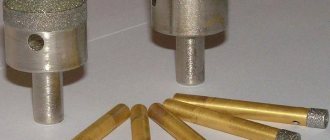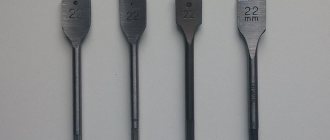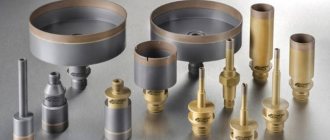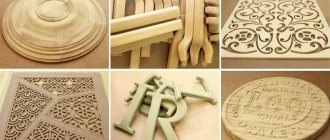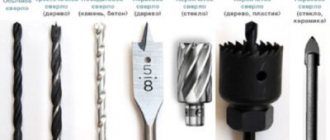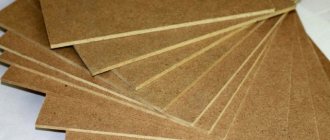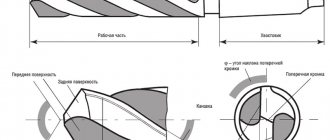Any repair, especially a major one, or construction work involves working with wood and processing it, which requires not only high-quality, but also correctly selected tools. One of the simplest processes in working with wood is drilling.
Wood drill bits
What to look for when choosing
Before purchasing a part, you need to familiarize yourself with its characteristics, make sure that there are no defects: chips, dents, nicks, scratches and others. Any of these shortcomings negatively affects the quality of work performed. A defective tool will not last long.
The assembly technology is determined by the color of the product:
- Black. The steam treatment method was used, it increases strength.
- Yellow-gold. The technology was aimed at relieving metallic stress.
- Bright gold. Titanium nitride is used to extend service life.
- Steel gray. Finishing was not carried out, the tool was not reinforced with additional spraying.
This is interesting: DIY inverter welding machine repair
Types of tools
Any modern electric drill includes a standard set of drills, which differ in size and length. But sometimes for some types of work this kit is not enough, so certain types of products have to be purchased additionally.
Screw products
diameter screw drills for wood are suitable for drilling holes of large diameter and depth This product is easy to use and is often used by workers who build log houses. The products are made in two types: with a conical tip and with a scoring tip. They are identical in performance. You can start working immediately after connecting the unit to the power tool. Screw models are produced in lengths of 220, 450 and 600 mm. Tool Features:
- The most common option is the 600 mm long model. It is suitable for drilling holes in thick products.
- The screw model is used if it is necessary to drill holes in log houses through 3 logs.
- The assembly in the drill chuck is securely secured using a hex shank.
- To get the job done more efficiently, you need to use a drill with a rotation speed of 800 rpm.
- The edges of the holes are smooth, and the inner walls are smooth.
Forstner drill
The Forstner drill has many positive advantages. That is why it is often used in furniture production. These are reliable massive units ranging from 10 to 60 mm. The drilling depth is about 10 cm. If you need to drill a deeper hole, you can purchase an additional 300 mm extension. Advantages of the tool:
- Unlike other models, this drill creates a perfectly even edge and a smooth inner surface of the hole made.
- Has a long service life.
- Suitable for creating blind recesses for locks and cup hinges.
- Thanks to the massive design, the tool does not overheat.
The centering spike of the drill protrudes a few centimeters, and this allows you to drill blind holes. Other tools do not have this function.
Feather models
Feather models are the most popular because they are simple and easy to use. Even a person without experience can master working with this tool. The drilling diameter ranges from 10 to 60 mm with a maximum drilling depth of about 150 mm. Advantages of the tool:
- You can purchase drills individually or as a set. The set includes products of 5-6 pieces, which are small in size. Large wood drill bits are sold individually.
- Due to the lack of chip removal, creating a deep hole becomes problematic. But you can avoid this by using an extension cord. An additional extension will help securely fix the drill and increase its length by 300 mm.
- There is now a new model of pen drills called the adjustable pen. The tool allows you to create holes with a diameter from 22 to 76 mm at low speeds. But at the same time, the power tool must have sufficient power.
The disadvantage of feather products is the holes are of poor quality. If you work fast enough, the result will not be perfect. Having a fragile structure, you cannot put strong pressure on the tool while drilling holes.
Ballerina on wood
The design of the device is similar to a compass. The drill is installed in the middle. And the cutting parts are attached on both sides, move along the crossbar and are fixed in different positions. Many people know this device under a different name. People call it a wood ballerina. Unlike other models, this device has the most diverse range of all kinds of hole drilling. The diameter can vary from 30 to 140 mm. You need to buy this model carefully, as there are many fakes on sale. Advantages of the tool:
- The ballerina perfectly processes wooden products with a thickness of no more than 20 mm, as well as sheet blanks.
- Copes well with a variety of materials: plywood, fiberboard and chipboard, etc.
- The kit includes a center punch, which is used to make marks on the surface of the product. The hex key helps set the cutting units in the desired position.
Cutting units are subject to heavy loads during operation. To prevent them from breaking, the drilling process should take place at low speeds.
Ring models
Ring models have many advantages , which is why they are very popular among craftsmen. This device is designed to create large diameter holes. Ring products received a second name - tree crowns. Outwardly, they look like a ring, the edges of which are equipped with sharp teeth.
- This tool allows you to drill a large hole quickly and easily. The drilling range varies from 19 to 127 mm.
- Drills are sold in sets of 6 to 12 pieces, so the cost of the set is quite high.
Cheap ring sets are disposable because they are of very low quality.
Milling cutter
If it is necessary to perform complex processing of elements made of wood or thin metal, milling models are used . With their help you can make grooves of various parameters. First, a round hole is drilled, and then it is bored to a certain shape. The tail part of the tool has a cylindrical shape, it can also be conical, triangular, tetrahedral and hexagonal:
Tapered shank is used in production equipment.- The triangular shank is installed only in a three-jaw chuck. Large loads will not be able to rotate it in the chuck, since it is very well secured.
- Square instruments are used in rare cases.
- The hex drill fits standard and three-jaw chucks. Under heavy loads it can turn in the chuck.
Flexible drill
There is no such tool as a flexible drill. This name is given to flexible shafts . They operate on a drive principle. One end of the flexible shaft is installed in the chuck of a power tool, and a milling cutter or drilling element is put on the other. Rotation is transmitted from the chuck to the drill. This tool is convenient because it can be used to reach hard-to-reach places. Large drills are not suitable for the tool; only small and medium diameters are suitable.
Long wood drills
The length of the drill depends on its diameter. A product that is too thin may break, so models that are too thin and long are not produced. A drill whose length is 45 cm has a diameter of 10 mm. And a product 60 cm long is 12 mm. If you do not drill a hole in thick beams, there is no point in buying such a product. When buying any drill, you should follow the proportions. For example, a simple household drill will not be able to turn a tool whose length is 45 cm and diameter is 52 mm.
Usage algorithm
There are a number of recommendations that should be followed when working with feather drills:
- Before starting work with the hole, you need to make markings on the wooden surface. This is the point where the Point is inserted. Before drilling, you need to deepen the point using a core.
- To work with the pen, you need to have an adjustable drill at your disposal. This is especially important when you need to work with several hole diameters. The rotation speed must be inversely proportional to the diameter of the drill, otherwise it may break if the speed is too high.
- When working with deep holes, it is important to also have an extension included with the drill, which helps increase the useful penetration depth by up to 30 millimeters.
- Before going deeper into the wood, you need to use cutters to outline the circle of the hole. To make a clear mark, it is important to enter the wood at low speeds. It is very important to maintain a vertical position when deepening, while pressing on the tip with little effort.
- When working with a feather, it is important to manually remove wood dust and sawdust from the hole, since the design does not allow them to be automatically removed after cutting. To do this, it is worth stopping work from time to time and removing it from the hole.
Tips for choosing
An instrument of any form has its own criteria and must meet them. You can determine the quality of the instrument you are purchasing by its appearance, color, and also by the material from which it is made.
- Material . It is impossible to visually determine the quality of the material. Therefore, before purchasing, you need to make sure that the product has a quality certificate. Chinese counterfeits are often sold without documents.
- Appearance . A high-quality product has a flat, smooth surface. Various cracks, scratches and damage are defective. The cutting area must be carefully sharpened. Long drills must be straight. It is very easy to check their quality; just roll them on a flat surface. All irregularities will be immediately visible.
Color . To ensure that the tool has additional strength, it is manufactured using a special technology. You can find out which processing method was used by the color of the product. The steel color indicates that no additional processing was carried out. The yellow-gold spraying relieves metallic stress. A product treated with titanium nitride (a tool with a bright gold color) will have a long service life. The black drill has increased strength. Steam was used to process it.- Package . Products from well-known manufacturers have good, high-quality packaging. All fakes are poorly packaged, and the text is sometimes written with errors.
- Price . The higher the price, the better the quality of the product. All budget tools have a short service life.
Caring about their reputation, well-known stores will not sell counterfeits. And no matter what kind of tool you buy, in order for it to be of high quality and last a long time, you should contact reliable and trusted suppliers.
Purchase Features
In order to purchase a quality pen, sometimes you have to spend a long time searching for the best manufacturer or store. Today, a large assortment of feather drills is offered, and there are many brands under which they are sold. When purchasing a feather drill, you should pay attention to the following circumstances:
- the shape of the pen on wood should be symmetrical;
- high requirements for the surface, which must be flat;
- If a chip or asymmetry is found, the nib should be discarded since it may have been made by hand and not at the factory.
It is very important to know what the feather should look like and what color it should be. Since the strength of the metal depends on the color and its quality manufacturing. The last feature allows you to determine how long and how well the pen will last.
The presence of the usual steel color indicates that the feather has not been subjected to additional reinforcement. If the metal is dark, then it was most likely treated with hot steam.
Golden hues may indicate either internal pressure treatment or coating of the material with ultra-strong titanium, a compound that increases the strength and life of the drill. In general, a set of feather drills for wood may include parts processed differently and with different diameters of 40, 50 mm, etc.
Hardened feather drill
To sharpen a pen for wood, you need to have a flat file on hand; in order to sharpen it correctly, you need to compare it with a working copy. There are two important requirements when sharpening. The incisors must be symmetrical, the tip must be strictly in the center. If it is skewed to one side or the other, the pen will simply break or jam. Since the cost of feather drills is quite low, they can be quickly replaced with new ones.
How to choose?
Craftsmen who work with wood often wonder how to choose the best drill bits for drills and screwdrivers. When deciding on a nozzle for forming holes in plywood or chipboard, it is worth considering important points.
- Drill material The best parts are those made from a metal alloy. Such products are characterized by high levels of wear resistance and strength.
- Presence of marriage. The consumer must carefully inspect the drill for the presence of cracks and deformations. Defects on the nozzle can cause poor performance results.
- Color . Yellow drill models are considered the highest quality. Black tips have proven themselves to be quite good, while gray tips are considered the most short-lived.
- Package . A high-quality product intended for woodworking should be packaged in a durable box.
- Price . As practice has shown, the cost of a set of drills has a direct impact on the quality of the product. Budget-type models are characterized by a short period of use.
Nowadays on the market there are sets with drills for working with wood , which contain models with different lengths and diameters. In this case, the craftsman should ensure that each product has a well-pointed tip. A drill that has a diameter of more than 10 mm must have a 6-sided shank.
Flaws
Despite all the strengths of pen nozzles for woodworking, they have one single drawback. It lies in the fact that this tool has a limited cutting diameter, which does not exceed 6 cm. As a result, only pointed end cutters take part in the drilling process. In this case, the rounded sides of the drill come into contact with the edges of the groove, on which wood fibers are formed. As a result, the surfaces of the holes are rough and not neat enough. Judging by the few reviews, these wood cutting bits become dull very quickly and require frequent re-sharpening.
Getting a Big Hole
Home craftsmen are often interested in how to make a hole in a tree of large diameter. There are several ways you can do this:
- A circle of the required diameter is drawn. A small drill is used to drill inside the circle of holes. Then, using a chisel, the jumpers are cut out.
- Take a water pipe. One side is sharpened for teeth in the direction of the cut. In the second, a hole is made for the knob. The pipe is placed against the surface and slow rotation begins.
- At the first stage, a through hole of smaller diameter is drilled. At the second stage, a crown is taken and inserted to the maximum depth. At the final stage, the under-drilled wood is knocked out with a chisel. Chips will not occur because the crown has already set the direction.
Wood drills have a broad classification. This is an important item at home. However, each type of work requires the use of a specific tool. With the help of one, holes are made, the other - countersinks, the third - grooves. Knowing all these subtleties, it is necessary to have sets of such drills that will never lie around the household.
This is interesting: Homemade sandblasting gun: device, instructions, video
Features and areas of use
A wood drill is easy to find in a specialty store or on the construction market. It is used to make holes in wood materials. Typically, the functionality of the drill is limited, so if it is overloaded, it may break. Experts recommend using it in accordance with the technical parameters and capabilities.
The set of drills contains various models that can work with wooden surfaces of different thicknesses and specific types of wood. For example, a 20 mm product can cope with oak, alder and cedar. Often the drill has a hexagonal base with a volume of 5 to 50 mm.
High-quality products are always well sharpened, so they are tightly fixed to the surface. A large base has a low drilling speed. Interaction is based on the frictional force between elements. A set of high quality fixtures is usually yellow in color , this shade indicates the presence of titanium dioxide in the alloy. Yellow drills have a long service life, unlike gray drills, which are disposable.
The strong and wear-resistant drill is black in color, as it is produced by hardening the metal. Since modern interiors contain a large number of wooden elements, in order to fix them, it is necessary to use special drills that accurately and correctly make the necessary holes.
A wood drill bit can be used to create two types of holes.
- Deaf . In this case, there is no exit from the reverse side of the material. Using these holes you can mount hinges for installing an interior door or furniture door.
- Through . This type of hole is necessary for installing a door handle or lock.
The advantages of attachments that are used for drilling wood are a wide range of models, the ability to extend and sharpen if necessary, as well as ease of operation.
Flaws:
- limited diameter;
- possibility of forming rough holes;
- tendency to periodic dulling.
Characteristics
The appearance of a feather drill is quite accurately described by its name. The rod, at the working end of which there is a so-called cutting blade, is attached to the drill using a hexagonal tip. The cutting part resembles a feather, and along the axis of the drill there is a point in the center, which is intended for centering when making holes. Two incisors on the sides of the tip form the blade itself.
There are two types of feather drills - single-sided and double-sided.
There are two types of pen: single-sided and double-sided. The type of drill depends on whether it can work in one direction or in both directions at once, that is, clockwise and counterclockwise, which is typical for double-sided drills. At the same time, the cutting angle on the cutters of different types of drills is different. Standardly, single-sided pens cut wood at an angle of 70-90 degrees, and a double-sided drill, in turn, has a cutting angle in the range of 120-135 degrees.
Typically, the length of the drill is 150 millimeters, and when using additional attachments - up to 180 millimeters. The standard working diameter of the pen is in the range from 5 to 60 millimeters. The most commonly used diameters are 10, 16, 18, 20, 25, 32 millimeters, and only sometimes 40 millimeters. Diameters greater than 60 millimeters are not used because the increasing surface area to be machined makes it difficult to machine holes.
Sharpening rules
Despite the fact that wood drills can be used for many years, in some cases the product needs to be sharpened. If the attachment begins to creak in the first minutes of operation, it means that it is time to sharpen it. The procedure can be carried out on a machine or using special devices. Craftsmen who are provided with special equipment will have no problems restoring the functionality of a metal product.
At home, a craftsman can use an electric machine with a sharpening stone. The type of sharpening is influenced by the shape of the product. Usually the procedure is carried out on the rear edges; in this case, the feathers should be processed evenly. To sharpen a drill, it is pressed against the end of a grinding stone and rocked by hand to create a conical surface.
During sharpening, the product must not be removed from the stone . The nature of the movements should be slow and smooth. For the procedure to be successful, the original shape of the product should be maintained as much as possible. In production, after the tool has been sharpened, it is recommended to fine-tune it. This procedure can smooth the surface and eliminate nicks.
After finishing work, the drills do not wear out so quickly. To carry out this procedure, use a round carbide grinding stone. If the cutting part of the drill is too sharp, then it is not worth sharpening it. Due to the fact that such a product is inexpensive, it would be advisable to replace it with a new one.
A drill for wood material is characterized by a simple design , but it is simply irreplaceable when it is necessary to create a hole in a soft or hard material. Usually, a high-quality drill has a high cost; if the product is cheap, then you should refuse to purchase it, since such a product will not last long. There is nothing complicated in using a drill, so even a novice master can drill through wood.
Experts advise adhering to basic safety rules when working with drills, as well as other cutting tools.
You can learn how to sharpen a metal drill into a wood drill from the video below.
Difference from conventional drills
In most cases, when building wooden structures (from small to large), it is necessary to drill holes of different diameters. They are most often used to fasten or hinge wooden parts.
The wood tip drill allows you to drill holes with a diameter of more than 60 mm
Conventional metal drills are not suitable for such work with lumber, since in most cases they are designed for small diameters and more durable materials, while feather drills do an excellent job of drilling holes with a diameter of 40, 50 and 60 mm, while most drills cannot make holes even 40 mm in diameter.
The feather drill has one drawback: it is not suitable for precise finishing work, so it is most often used for rough processing.
Overview of species
Wood drills come in different sizes, diameters and purposes, but they look similar. On sale you can find many varieties of this device. To perform a specific task, a craftsman can purchase a large adjustable, beam, cup, circle, hand, slotting, extension, formwork, through, centering or sliding drill.
Screw
For spiral-type drills, the working part is presented in the form of a screw . Craftsmen use this attachment when preparing holes with small diameters. A feature of the screw design is that, in addition to its main purpose, it effectively removes chips. Thanks to the use of twist drills, drilling occurs accurately and accurately.
This category of devices includes an auger type of Lewis drill , which has an improved working part.
Such a tool is considered relevant for forming a deep hole, which also has a large diameter.
Feather
This type of drill for working with wood surfaces is used if you want to create a hole with a diameter of less than 25 mm . It is used when there are no strict requirements for compliance with parameters.
These metal products are characterized by low price and ease of maintenance.
Forstner
Unusual Forstner tips are used by craftsmen to create a blind hole rather than a through one. If this type of product is used in conjunction with additional accessories, it is even possible to make a square hole.
Circular
They are also called ballerinas . Thanks to them, craftsmen create large holes in plywood, chipboard, and wood.
This drill bit can also be used for drilling tiles.
Ring
Crowns are needed to produce large-diameter holes, namely from 1.9 to 12.7 cm in boards, plywood or lining. Using a ring drill, craftsmen produce round blanks and wide holes, which are later indispensable when installing spotlights.
Crowns can have different diameters and a removable base.
Milling cutters
The milling attachment not only drills wood, but also makes grooves in it with different configurations. The use of devices of this type is considered most relevant when complex processing of wooden surfaces is necessary.
The main difference between a cutter and another wood drill is the presence of a cutting edge along the entire device.
Flexible
Flexible drills are shafts with a drive mechanism that transmit torque from the chuck to the tool. This device must be used in conjunction with an electric drill, screwdriver or drill.
With the help of a flexible shaft, it became possible to make holes even in hard-to-reach places.
Long
The long nozzle for forming holes in a wood surface depends on the diameter . Consumers will not be able to find thin and long drills on sale; often the opposite is true: short products have the smallest thickness.
The use of long-length drills is especially important when it is necessary to drill through a thick wooden block.
Classification by size
To choose the best drill and not overpay, it is enough to know what length sizes these products are usually divided into. If drilling metal does not require making deep holes, then purchasing models that are too long will lead to cost overruns.
It is customary to classify drills by length as follows:
- Short, 20-131 mm long. Tool diameters are in the range of 0.3-20 mm.
- Elongated, length is 19-205 mm, and diameter is 0.3-20 mm.
- Long series with a diameter of 1-20 mm and a length of 56-254 mm.
When performing drilling work of various depths, you should select the tool that is most suitable for the specific task.
Simplicity of the device and wide possibilities: ballerina on wood
If it is necessary to make a large-diameter hole in the material, a drill can be used, which in everyday life has received a very euphonious name - ballerina (due to the external similarity of the separated cutting elements of the device with the image of a dancer). Such a device consists of a centering drill and cutters, which move apart along the guide in different directions at the same distance, thereby outlining the dimensions of the diameter of the future hole. Most ballerinas have two incisors, but there are also models with three.
The operating principle of this type of drill bit:
- the central drill makes a hole in the material;
- the incisors mark a circle line, which determines the size of the future recess;
- The device is set in motion manually (using a rotary tool) or using a rotary power tool.
With a ballerina, you can make holes in wood, wood materials, drywall, ceramic tiles, and plastic. This attachment is inexpensive and quite suitable for non-professionals.
Helpful advice! When using a ballerina as an attachment for a manual mechanism, efforts should be made when carrying out the centering and first rotational movements of the incisors, outlining the contour of the future recess. Uncertain movements can cause chips on the top edge of the material.


